 Clotilde Davenne 2022 Bourgogne Côtes d’Auxerre 93
Clotilde Davenne 2022 Bourgogne Côtes d’Auxerre 93
It’s common knowledge that Burgundy produces sensational, sought-after, and expensive wines. Less well known is that the region also produces excellent and affordable wines, such as this white Burgundy, that is currently available in the U.S. for about $25 USD per bottle. I realize that retail markets are heterogeneous, distribution is spotty, and all wines are not available everywhere. That’s especially the case with Burgundy, where production of individual cuvées is typically tiny. Nonetheless, I highlight this wine because it is emblematic of what bargains are available even in the sought-after, high-flying Burgundy market.
Since the producer’s name is the single most important piece of information on a bottle’s label, let’s start there. Clotilde Davenne is one of Burgundy’s top producers. From my tasting her wines many times over the last decade during the biennial Grands Jours de Bourgogne and other events, it’s crystal clear that Clotilde Davenne produces consistently excellent wines from her 30-ha (75-acre) estate that encompasses St. Bris, Chablis, Irancy, Crémant de Bourgogne, and Côtes d’Auxerre. Based in the tiny hamlet of Préhy, equidistant from Chablis, Irancy, and Saint-Bris-le-Vineux, her talents span the spectrum of grapes grown in this northernmost outpost of Burgundy: Sauvignon Blanc, Chardonnay, Aligoté, and Pinot Noir. Davenne trained in oenology, worked in Beaujolais and made sparkling wine in California before immersing herself in Chablis where she began the chief oenologist for the noted Chablis producer, Jean-Marc Brocard. She left that post in 2005 to start her own project, Domaine des Temps Perdus.
Bourgogne Côte d’Auxerre is one of the regional appellations under the larger Bourgogne umbrella. In the past, grapes from this northern clime—vineyards spreading west from Chablis to the town of Auxerre, but mostly surrounding St. Bris—would have difficulty ripening, producing angular and harsh wines. With climate change, this small (roughly 250-ha) area can now produce fine wine. One producer from the area exclaimed to me, “We can make wine with ripe grapes!” The soil here is a variable mixture of clay, Kimmeridgian and Portlandian limestone, like Chablis. More and more Chablis-based producers are expanding here where vineyard land is more affordable. In addition to Davenne, another top producer her is Guilhem & Jean-Hugues Goisot. Like Davenne, their wines do not disappoint.
Davenne’s bold 2022 Bourgogne Côtes d’Auxerre, made exclusively from Chardonnay, delivers firm minerality accented by a riveting lemon-tinged acidity, which amplifies its appeal. While it may lack the finesse of Chablis, the enjoyment it delivers for the price, makes it a no-brainer for current consumption. It’s balance and structure suggest it will develop nicely over the next five years, so stock up. Drinking window: 2025-2030.
